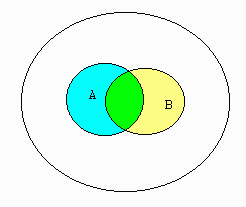Probability and Independence
- Page ID
- 217
For an experiment we define an event to be any collection of possible outcomes. A simple event is an event that consists of exactly one outcome.
- "or" means the union (i.e. either can occur)
- "and" means intersection (i.e. both must occur)
Two events are mutually exclusive if they cannot occur simultaneously. For a Venn diagram, we can tell that two events are mutually exclusive if their regions do not intersect
We define probability of an event \(E\) to be to be
\[P(E) = \dfrac{\text{number of simple events within E}}{\text{ total number of possible outcomes}} \nonumber \]
We have the following:
- \(P(E)\) is always between 0 and 1.
- The sum of the probabilities of all simple events must be 1.
- \(P(E) + P(\text{not } E) = 1\)
- If \(E\) and \(F\) are mutually exclusive then
\[ P(E \text{ or } F) = P(E) + P(F) \nonumber \]
The Difference Between "and" and "or"
If \(E\) and \(F\) are events then we use the terminology
\[ E \text{ and } F \nonumber \]
to mean all outcomes that belong to both \(E\) and \(F\).
We use the terminology
\[E \text{ or } F \nonumber \]
to mean all outcomes that belong to either \(E\) or \(F\).
Below is an example of two sets, \(A\) and \(B\), graphed in a Venn diagram.

The green area represents \(A\) and \(B\) while all areas with color represent \(A\) or \(B\)
Our Women's Volleyball team is recruiting for new members. Suppose that a person inquires about the team.
- Let \(E\) be the event that the person is female
- Let \(F\) be the event that the person is a student
then \(E\) and \(F\) represents the qualifications for being a member of the team. Note that \(E\) or \(F\) is not enough.
We define
\[ P(E|F) = \dfrac{P(E \text{ and } F}{P(F)} \nonumber \]
We read the left hand side as "The probability of event \(E\) given event \(F\) occurred."
We call two events independent if the following definitions hold.
For independent Events
\[P(E|F) = P(E) \label{1a} \]
Equivalently, we can say that \(E\) and \(F\) are independent if
For Independent Events
\[P(E \text{ and } F) = P(E)P(F) \label{1b} \]
Consider rolling two dice. Let
- \(E\) be the event that the first die is a 3.
- \(F\) be the event that the sum of the dice is an 8.
Then \(E\) and \(F\) means that we rolled a three and then we rolled a 5
This probability is 1/36 since there are 36 possible pairs and only one of them is (3,5)
We have
\[ P(E) = 1/6 \nonumber \]
And note that (2,6),(3,5),(4,4),(5,3), and (6,2) give \(F\)
Hence
\[ P(F) = 5/36 \nonumber \]
We have
\[ P(E) P(F) = (1/6) (5/36) \nonumber \]
which is not 1/36 and we can conclude that \(E\) and \(F\) are not independent.
Test the following two events for independence:
- \(E\) the event that the first die is a 1.
- \(F\) the event that the sum is a 7.
A Counting Rule
For two events, \(E\) and \(F\), we always have
\[ P(E \text{ or } F) = P(E) + P(F) - P(E \text{ and } F) \label{2} \]
Find the probability of selecting either a heart or a face card from a 52 card deck.
Solution
We let
- \(E\) = the event that a heart is selected
- \(F\) = the event that a face card is selected
then
\[ P(E) = \dfrac{1}{4} \nonumber \]
and
\[ P(F) = \dfrac{3}{13} \nonumber \]
that is, Jack, Queen, or King out of 13 different cards of one kind.
\[ P(E \text{ and } F) = \dfrac{3}{52} \nonumber \]
The counting rule formula (eq. 2) gives
\[ P(E \text{ or } F) = \dfrac{1}{4} + \dfrac{3}{13} - \dfrac{3}{52} = \dfrac{22}{52} = 42\text{%} \nonumber \]
Contributors
- Larry Green (Lake Tahoe Community College)


